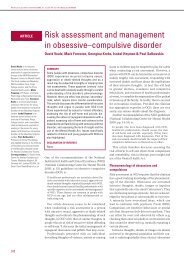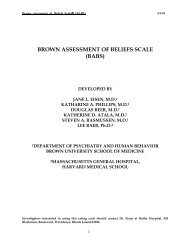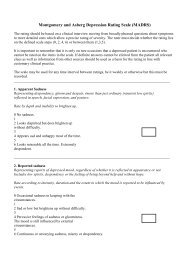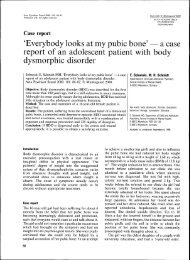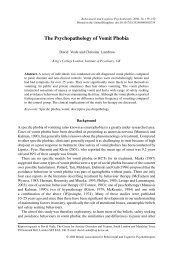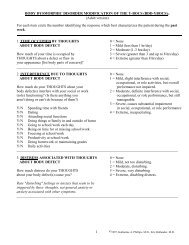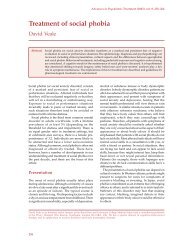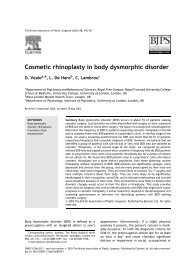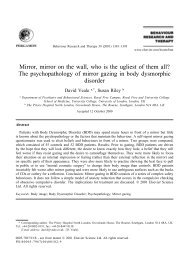Cognitive behaviour therapy for a specific phobia of vomiting
Cognitive behaviour therapy for a specific phobia of vomiting
Cognitive behaviour therapy for a specific phobia of vomiting
You also want an ePaper? Increase the reach of your titles
YUMPU automatically turns print PDFs into web optimized ePapers that Google loves.
288 D. VealeMcFadyen M, Wyness J (1983). You don’t have to be sick to be a <strong>behaviour</strong> therapist but it can help!Treatment <strong>of</strong> a vomit <strong>phobia</strong>. Behavioural Psycho<strong>therapy</strong> 11, 173–176.McKenzie S (1994). Hypno<strong>therapy</strong> <strong>for</strong> <strong>vomiting</strong> <strong>phobia</strong> in a 40-year-old woman. ContemporaryHypnosis 11, 37–40.McNally RJ (1997). Vomiting <strong>phobia</strong>. In: Phobias: a Handbook <strong>of</strong> Theory, Research and Treatment (ed.G. C. Davey), pp. 186–187. Chichester: Wiley.Moran DJ, O’Brien RM (2005). Competence imagery: a case study treating emeto<strong>phobia</strong>. PsychologicalReports 96, 635–636.O’Connor JJ (1983). Why can’t I get hives: brief strategic <strong>therapy</strong> with an obsessional child. FamilyProcess 22, 201–209.Ohman A, Mineka S (2001). Fears, <strong>phobia</strong>s, and preparedness: toward an evolved module <strong>of</strong> fear andfear learning. Psychological Review 108, 483–522.Philips HC (1985). Return <strong>of</strong> fear in the treatment <strong>of</strong> a fear <strong>of</strong> <strong>vomiting</strong>. Behaviour Research Therapy23, 45–52.Porges SW (2007). The polyvagal perspective. Biological Psychology 74, 116–143.Ritow JK (1979). Brief treatment <strong>of</strong> a <strong>vomiting</strong> <strong>phobia</strong>. American Journal <strong>of</strong> Clinical Hypnosis 21,293–296.Salkovskis PM, Wroe AL, Gledhill A, Morrison N, Forrester E, Richards C, Reynolds M, Thorpe S(2000). Responsibility attitudes and interpretations are characteristic <strong>of</strong> obsessive compulsive disorder.Behaviour Research and Therapy 38, 347–372.Smucker MR, Dancu CV (1999). <strong>Cognitive</strong> Behavioral Treatment <strong>for</strong> Adult Survivors <strong>of</strong> ChildhoodTrauma: Rescripting and Reprocessing. Northvale, NJ: Jason Aronson.Stinson FS, Dawson DA, Chou PS, Smith S, Goldstein R, Ruan J, Grant B (2007). The epidemiology<strong>of</strong> DSM-IV <strong>specific</strong> <strong>phobia</strong> in the USA: results from the National Epidemiologic Survey on Alcoholand Related Conditions. Psychological Medicine 37, 1047–1059.van Overveld M, De Jong PJ, Peters ML, Van Hout WJPJ, Bouman TK (2008). An internet-basedstudy on the relation between disgust sensitivity and emeto<strong>phobia</strong>. Journal <strong>of</strong> Anxiety Disorders 22,524–531.Veale D, Lambrou C (2006). The psychopathology <strong>of</strong> vomit <strong>phobia</strong>. Behavioural and <strong>Cognitive</strong>Psycho<strong>therapy</strong> 34, 139–150.Wijesinghe B (1974). A <strong>vomiting</strong> <strong>phobia</strong> overcome by one session <strong>of</strong> flooding with hypnosis. Journal<strong>of</strong> Behavioural Therapy and Experimental Psychiatry 5, 169–170.Wild J, Hackmann A, Clark DM (2008). Rescripting early memories linked to negative images insocial <strong>phobia</strong>: a pilot study. Behavior Therapy 39, 47–56.Wolitzky-Taylor KB, Horowitz JD, Powers MB, Telch MJ (2008). Psychological approaches in thetreatment <strong>of</strong> <strong>specific</strong> <strong>phobia</strong>s: a meta-analysis. Clinical Psychology Review 28, 1021–1037.Learning objectivesBy the end <strong>of</strong> this article, the reader will have obtained knowledge on:(1) Epidemiology, clinical characteristics and differential diagnosis <strong>of</strong> a <strong>specific</strong> <strong>phobia</strong><strong>of</strong> <strong>vomiting</strong> (SPOV).(2) Making an assessment and <strong>for</strong>mulation in a person with SPOV.(3) Provide psycho-education about <strong>vomiting</strong> and plan a programme <strong>of</strong> change.(4) Using exposure in vivo or <strong>behaviour</strong>al experiments in a person with SPOV.(5) Identify safety seeking <strong>behaviour</strong>s and compulsions that interfere in exposure.



